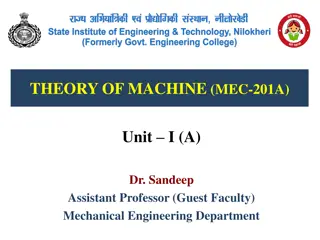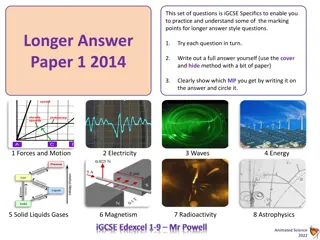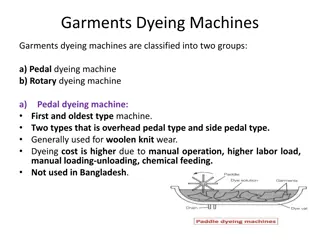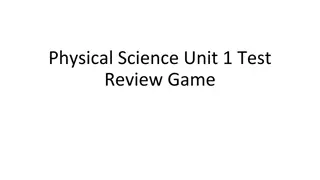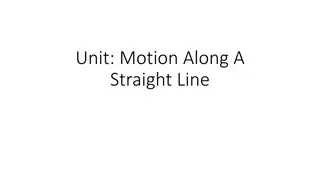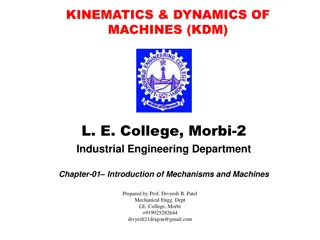Understanding Motion, Forces, and Machines in Physical Science
Explore the fundamental concepts of motion, forces, and machines in physical science. Learn about distance, displacement, speed, velocity, acceleration, forces, and friction. Understand how these concepts shape our understanding of the physical world and impact the behavior of objects in motion.
Download Presentation

Please find below an Image/Link to download the presentation.
The content on the website is provided AS IS for your information and personal use only. It may not be sold, licensed, or shared on other websites without obtaining consent from the author. Download presentation by click this link. If you encounter any issues during the download, it is possible that the publisher has removed the file from their server.
E N D
Presentation Transcript
Physical Science Unit 1 Crash Course Chapter 11, 12, and 14 (Motion, Forces, and Machines)
Chapter 11 - Motion Distance is the length of a path between two points. Displacement is the direction from the starting point and the length of a straight line from the starting point to the ending point. When two displacements, represented by two vectors, have the same direction, you can add their magnitudes. If two displacements have opposite directions, the magnitudes subtract from each other.
Chapter 11 - Motion Speed is the ratio of the distance an object moves to the amount of time the object moves. Velocity is a description of both speed and direction. Velocity is a vector. A change in velocity can be a result of a change in speed, direction, or both. Velocity = distance time The SI unit of speed and velocity is meters per second (m/s).
Chapter 11 - Motion The slope of a line on a distance-time graph is speed. The steeper the slope of the line, the faster the speed. Straight lines represent constant speed.
Chapter 11 - Motion The rate at which velocity changes is called acceleration. Acceleration can be described as changes in speed, changes in direction, or changes in both. Free fall is the movement of an object toward the Earth solely because of gravity. Objects falling near Earth s surface accelerate downward at a rate of 9.8m/s2.
Chapter 11 - Motion The SI unit for acceleration is m/s2. a = vf vi t The slope of a speed-time graph is acceleration. Constant acceleration is represented by a straight line. On a distance-time graph, acceleration is represented by a curved line.
Chapter 12 - Forces A force is a push or pull that acts on an object. A force can cause a resting object to move, or can accelerate a moving object by changing the object s speed or direction. Force is measured in newtons (N). Forces combine by vector addition. When the forces on an object are balanced, the net force is zero and there is no change in the object s motion. An unbalanced force is a force that results when the net force acting on an object is not equal to zero.
Chapter 12 - Forces All moving objects are subject to friction, a force that opposes the motion of objects that touch as they move past each other. Static friction is the friction force that acts on objects that are not moving. Sliding friction is a force that opposes the direction of motion of an object as it slides over a surface. The change in shape when something rolls is the cause of rolling friction, the friction force that acts on rolling objects. The force of fluid friction opposes the motion of an object through a fluid. Fluid friction acting on an object moving through air is known as air resistance.
Chapter 12 - Forces Gravity is an attractive force that acts between any two masses. Gravity does not require objects to be in contact for it to act on them. As the speed of a falling object increases, so does the air resistance.
Chapter 12 - Forces According to Newton s first law of motion, the state of motion of an object does not change as long as the net force acing on the object is zero. Inertia is the tendency of an object to resist change in its motion. According to Newton s second law of motion, the acceleration of an object is equal to the net force acting on it divided by the object s mass. a = F/m According to Newton s third law of motion, for every force there is an equal and opposite force.
Chapter 12 - Forces Mass is the amount of matter an object contains. Weight is the force of gravity acting on an object. W = m x g Weight (W) = N mass (m) = kg gravity (g) = 9.8 m/s2
Chapter 12 - Forces All the universal forces act over a distance between particles of matter, which means that the particles do not need to be in contact with one another. Electromagnetic force is associated with charged particles. Two forces, the strong nuclear and the weak nuclear force, act within the nucleus to hold it together. Gravitational force is an attractive force that acts between any two masses. Newton s law of universal gravitation states that every object in the universe attracts every other object.
Chapter 12 - Forces Newton s law of universal gravitation states that every object in the universe attracts every other object. The gravitational force between two objects is proportional to their masses and decreases as the distance between them increases. Gravity is the weakest universal force, but it is the most effective over long distances.
Chapter 14 - Machines In science, work is the product of force and distance. Work is done when a force acts on an object in the direction the object moves. W = F x d The unit of force is newtons. The unit of distance is meters. The unit of work is the joule.
Chapter 14 - Machines Machines make work easier to do. They change the size of the force needed, the direction of a force, or the distance over which a force acts. If a machine increases the distance over which you exert a force, then it decreases the amount of force you need to exert. A machine that decreases the distance through which you exert a force increases the amount of force required. Because of friction, the work done by a machine is always less than the work done on the machine.
Chapter 14 - Machines The work done by the effort force acting through the effort distance is called the work input. The work output of a machine is the resistance force multiplied by the resistance distance. You cannot get more work out of a machine than you put into it. The mechanical advantage of a machine is the number of times that the machine increases the effort force. AMA = resistance force effort force IMA = effort distance resistance distance
Chapter 14 - Machines Some resistance force is lost due to friction. No machine has 100 percent efficiency due to friction. The six simple machines are:
Chapter 14 - Machines A lever is a rigid bar that rotates around a fixed point called the fulcrum. The wheel and axle is a simple machine consisting of a large disk (wheel) rigidly secured to a smaller disk (axle). An inclined plane is a slanted surface along which a force moves an object to a different elevation. The wedge is a V-shaped object whose sides are two inclined planes. Narrow wedges have a greater IMA. Screws with threads that are closer together have a greater IMA since it takes less force. A pulley is a simple machine that consists of a rope that fits into a groove in a wheel.




























